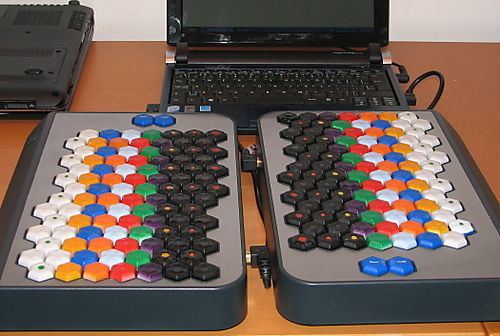 | ||
A jammer is a new musical instrument characterized by at least one isomorphic keyboard, and thumb-operated and/or motion-sensing expressive controls. The instrument is designed to be fast to learn to play, very fast to play, and very expressive.
Contents
- Origin of jammer and Thummer instruments
- Open source jammer
- Do It Yourself handmade jammers
- Touchscreen based jammers
- Origin and usage of the jammer name
- Features
- Limitations and disadvantages over a standard keyboard
- Differences from the Thummer design ideal
- How jammers are being made
- Design Rationale
- Ergonomic Factors
- Commercially available
- Software
- References
Research suggests that the combination of thumb-controls and internal motion sensors could give jammers more expressive potential than other polyphonic musical instruments such as the piano, guitar, and accordion. Isomorphic keyboards similar to those used in a jammer have been shown to accelerate the rate at which students grasp otherwise-abstract concepts in music theory.
Origin of jammer and Thummer instruments
The jammer was invented by Jim Plamondon in September 2003, whereupon he founded Thumtronics to design its "Thummer(tm)-brand jammer" and bring it to market, the trade name was to emphasize the unique thumb-control feature. Prototype Thummers were produced, but the effort to commercialize them failed, and Thumtronics was disbanded in mid-2009.
Open source jammer
Although not currently under commercial development, an ongoing open source hardware design project seeks to produce a royalty-free reference design for jammers, based on Thumtronics' prototypes.
Do It Yourself (handmade) jammers
Hobbyists are making DIY jammers. Recent availability of adaptable commercial keyboard controllers, especially the Axis-49 from C-Thru Music, has spurred innovation and many functioning jammers have been built. Software for their construction through the modification of commercially available instruments is now available.
Touchscreen based jammers
The many multitouch touchscreen products running Android or iOS, particularly tablet devices, can be adapted to be utilised as jammers. The dynamic display allows for key sizes to be easily adjusted to preference.
Origin and usage of the jammer name
Just as Kleenex(tm) is a trademarked brand of facial tissue, and the Stratocaster(tm) is a trademarked brand of electric guitar, the Thummer was intended to be a trademarked brand of "a new kind of musical instrument." The term jammer was introduced to give that "new kind of musical instrument" a generic, non-trademarked name. It was coined by Jim Plamondon, founder of Thumtronics, and first used when the "Thummer(tm)-brand jammer" was publicly announced on December 15, 2005, in Perth, Western Australia.
Features
Limitations and disadvantages over a standard keyboard
Differences from the Thummer design ideal
Jammers are forced to make do with an assembly of independent parts. The Thummer design patents are useful as a design goal, because of its many novel features.
How jammers are being made
Design Rationale
Of the large number of isomorphic note assignments possible, jammers use the Wicki-Hayden note layout. All scales fall in the center of the layout, directly under ones fingers, and it is simple to relate to conventional music notation. All conventional chord progressions can be easily fingered in the jammer arrangement with minimal hand movement.
Octaves ascend vertically, increasing the playable interval sizes, easing chord inversions, and greatly reducing the time needed to move to a new note or chord.
Ergonomic Factors
Although no one is yet expert on a jammer, Fitts law predicts that the jammer will be very significantly faster to play that a conventional keyboard. The expected speed increase is (log base 2 (30% smaller key / ~1000% distance decrease) or 75% less time to find and press the average key. Since playing an instrument is always a speed vs accuracy tradeoff, a novice player should be able to play more accurately, while a trained player should be able to play with more precise timing.
Commercially available
Some hexagonal isomorphic keyboards are commercially available:
Devices that do not use the wicki-hayden note layout natively can be converted to jammers by electronically remapping the notes received via USB midi to the wicki-hayden note layout.
